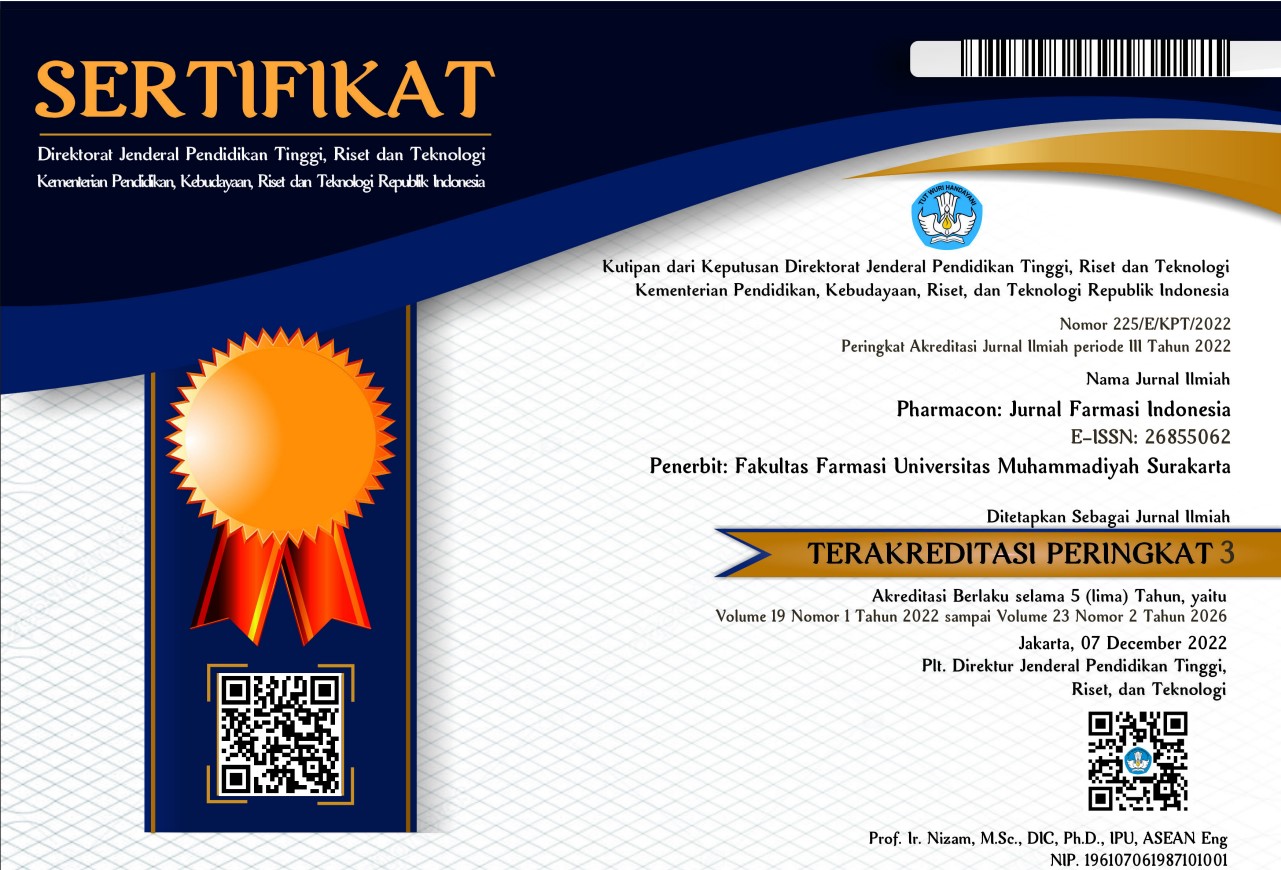Formulation And Evaluation Of Black Glutinous Rice Clay Mask (Oryza sativa L. Var Glutinosa) Using Bentonite And Kaolin Variations
DOI:
https://doi.org/10.23917/pharmacon.v21i1.3064Keywords:
Bentonite, Black glutinous rice, Clay mask, Formulation, KaolinAbstract
Black glutinous rice is a staple cuisine consumed frequently by Indonesians. Black glutinous rice's high anthocyanin content can stimulate collagen production. This study seeks to determine the effects of the kaolin and bentonite combination on different concentrations as a clay mask and obtain the optimal composition formula. Optimizing the clay mask formula using the factorial design procedure. The evaluation of a formula includes organoleptic, homogeneity, pH, irritation, and drying time tests. The research findings indicated that all preparations satisfied the evaluation criteria before the pH test. The results showed that kaolin can elevate the pH level, while bentonite can lower the pH. Preparations F1 and F2 satisfy the requirements, whereas F3 fails to fulfil the standards following the pH test. F1 (5 % bentonite and 15 % kaolin) and F2 (3 % bentonite and 25 % kaolin) were optimal clay mask formulas for black glutinous rice.
Downloads
References
Ahmad, Z., & Damayanti. (2018). Skin Aging: Pathophysiology and Clinical Manifestations. Berkala Ilmu Kesehatan Kulit Dan Kelamin – Periodical of Dermatology and Venereology, 30(03), 208–215. https://doi.org/10.20473/bikk.V30.3.2018.208-215
Chen, J., Liu, Y., Zhao, Z., & Qiu, J. (2021). Oxidative stress in the skin: Impact and related protection. International Journal of Cosmetic Science, 43(5), 495–509. https://doi.org/10.1111/ics.12728
Correia, P., Araújo, P., Ribeiro, C., Oliveira, H., Pereira, A. R., Mateus, N., de Freitas, V., Brás, N. F., Gameiro, P., Coelho, P., Bessa, L. J., Oliveira, J., & Fernandes, I. (2021). Anthocyanin-related pigments: Natural allies for skin health maintenance and protection. Antioxidants, 10(7). https://doi.org/10.3390/antiox10071038
Dewi, M. F., Nurhidajah, N., & Aminah, S. (2019). Anthocyanin Content, Total Phenols, and Sensory Properties of Black Rice Tape Flour Based on Variations in Processing Methods and Yeast Concentration. Jurnal Pangan Dan Gizi, 9(2), 94. https://doi.org/10.26714/jpg.9.2.2019.94-109
Fauziah, D. W. (2017). Effect of Kaolin and Bentonite Base on the Physical Properties of a Mud Mask Combination of Olive Oil and Green Tea (Camelia sinensis). Jurnal Farmasi, Sains, Dan Kesehatan, 3(2), 9–13. https://doi.org/10.33772/pharmauho.v9i2
Fauziah, F., Marwarni, R., & Adriani, A. (2020). Formulation and Physical Properties Test of Anti-Acne Mask from Coconut Fiber Extract (Cocos nucifera L). Jurnal Riset Kefarmasian Indonesia, 2(1), 42–51. https://doi.org/10.33759/jrki.v2i1.74
Febriani, Y., Sudewi, S., & Sembiring, R. (2022). Formulation And Antioxcidant Activity Test Of Clay Mask Extracted Ethanol Tamarillo (Solanum betaceum Cav.). Indonesian Journal of Pharmaceutical Science and Technology, 1(1), 22. https://doi.org/10.24198/ijpst.v1i1.36432
Gomes, C., Silva, A. C., Marques, A. C., Lobo, J. S., & Amaral, M. H. (2020). Biotechnology applied to cosmetics and aesthetic medicines. Cosmetics, 7(2), 1–14. https://doi.org/10.3390/COSMETICS7020033
Husna, N., Masrullita, Meriatna, Ginting, Z., & Jalaluddin. (2023). The Effect of Comparison between Rambutan Seeds (Nephelium Lappaceum L.) with Kaolin and Bentonite in Making Facial Masks Chemical Engineering Journal Storage, 3(3), 417–427. https://doi.org/10.29103/cejs.v3i3.11424
Hwang, J. H., Lee, S., Lee, H. G., Choi, D., & Lim, K. M. (2022). Evaluation of Skin Irritation of Acids Commonly Used in Cleaners in 3D-Reconstructed Human Epidermis Model, KeraSkinTM. Toxics, 10(10). https://doi.org/10.3390/toxics10100558
Jurecek, L., Rajcigelova, T., Kozarova, A., Werner, T., Vormann, J., & Kolisek, M. (2021). Beneficial Effects of an Alkaline Topical Treatment in Patients with Mild Atopic Dermatitis. Journal of Cosmetic Dermatology, 20(9), 2824–2831. https://doi.org/10.1111/jocd.13936
Khoo, H. E., Azlan, A., Tang, S. T., & Lim, S. M. (2017). Anthocyanidins and Anthocyanins: Colored Pigments as Food, Pharmaceutical Ingredients, and The Potential Health Benefits. Food and Nutrition Research, 61(1). https://doi.org/10.1080/16546628.2017.1361779
Kumalasari, E. K. et al. (2023). Preparation of Clay Mask from Red Pidada (Sonneratia caseolaris) Leaf Extract as an Antioxidant. Jurnal Insan Farmasi Indonesia, 6(1), 1–23. https://doi.org/10.36387/jifi.v6i1.1363
Lestari, U., Farid, F., Yuliawati, & Pratama, S. (2021). Irritation Test and Effectiveness of Facial Humidity Skin From Peel Off Gel Mask Based Of Date Palm Seeds Powder (Phoenix dactylifera). Journal BiGME, 1(2), 1–5. https://doi.org/10.22437/bigme.v1i2.15318
Lestari, U., Lestari, I., & Syam, N. R. (2018). Antioxidant activity and irritation test of peel off gel mask of pure palm oil as emollient. International Conference on Pharmaceutical Research and Practice, 182–185. https://dspace.uii.ac.id/handle/123456789/12313
Londhe, S. S., Joshi, A. A., Sapkale, G. N., & Bhosale, M. G. (2021). Formulation and Evaluation of Clay Face Pack. International Journal of Pharmaceutical Investigation, 11(4), 437–440. https://doi.org/10.5530/ijpi.2021.4.78
Nurtiana, W. (2019). Anthocyanin As Natural Colorant: a Review. Food ScienTech Journal, 1(1), 1–7. https://doi.org/10.33512/fsj.v1i1.6180
Pratiwi, J. (2023). Formulation and Physical Stability Test Peel Off Mask from Kokang Leaf Extract (Lepisanthes amoena (Haask) Leenh) as an Antioxidant. Indonesian Journal of Pharmaceutical Science and Technology, 1(1). https://doi.org/10.24198/ijpst.v0i0.47320
Safilla, A., Ardana, M., & Rijai, L. (2022). Clay Mask Formulation of Rosella Petal Extract (Hibiscus sabdariffa L.) Clay Mask as an Antioxidant. Proceeding of Mulawarman Pharmaceuticals Conferences, 15, 25–29. https://doi.org/10.25026/mpc.v15i1.612
Sayuti, N. A. (2015). Formulation and Physical Stability Test of Chinese Ketepeng (Cassia Alata L.) Leaf Extract Gel Preparation. Jurnal Kefarmasian Indonesia, 5(2), 74–82. https://doi.org/10.22435/jki.v5i2.3500
Setiyadi, G., & Qonitah, A. (2020). Optimization of Betel Leaf Ethanolic Extract Peel-Off Gel Mask (Piper Betle L.) with a combination of Carbomer and Polyvinyl Alcohol. Pharmacon: Jurnal Farmasi Indonesia, 17(2), 174–183. https://doi.org/10.23917/pharmacon.v17i2.11976
Suhartatik, N., Mustofa, A., & Mursito, P. (2019). Phenolic Content and Antioxidant Activity of Black Glutinous Rice Anthocyanin during Fermentation by Pediococcus pentosaceus N11.16. AgriTECH, 39(1), 30. https://doi.org/10.22146/agritech.36347
Syamsidi, A., Sulastri, M.Si.,Apt, E., & Syamsuddin, A. M. (2021). Formulation and Antioxidant Activity of Mask Clay Extract Lycopene Tomato (Solanum lycopersicum L.) with Variation of Concentrate Combination Kaoline and Bentonite Bases. Jurnal Farmasi Galenika (Galenika Journal of Pharmacy) (e-Journal), 7(1), 77–90. https://doi.org/10.22487/j24428744.2021.v7.i1.15462
Wahid, H., Karim, S. F., & Sari, N. (2022). Formulation of Anti-aging Cream from Collagen Extract of Milkfish Scale Waste (Chanos chanos). Jurnal Sains Dan Kesehatan, 4(4), 428–436. https://doi.org/10.25026/jsk.v4i4.1289
Wikantyasning, E. R., Nurhakimah, U. F., Sula, R. D., & Astuti, K. F. (2019). Optimization of Essence Sheet Mask Formulation: Combination of Spirulina platensis Extract and Bentonite Nanoparticles using the Simplex Lattice Design Method. Pharmacon: Jurnal Farmasi Indonesia, 16(1), 18–27. https://doi.org/10.23917/pharmacon.v16i1.8307










